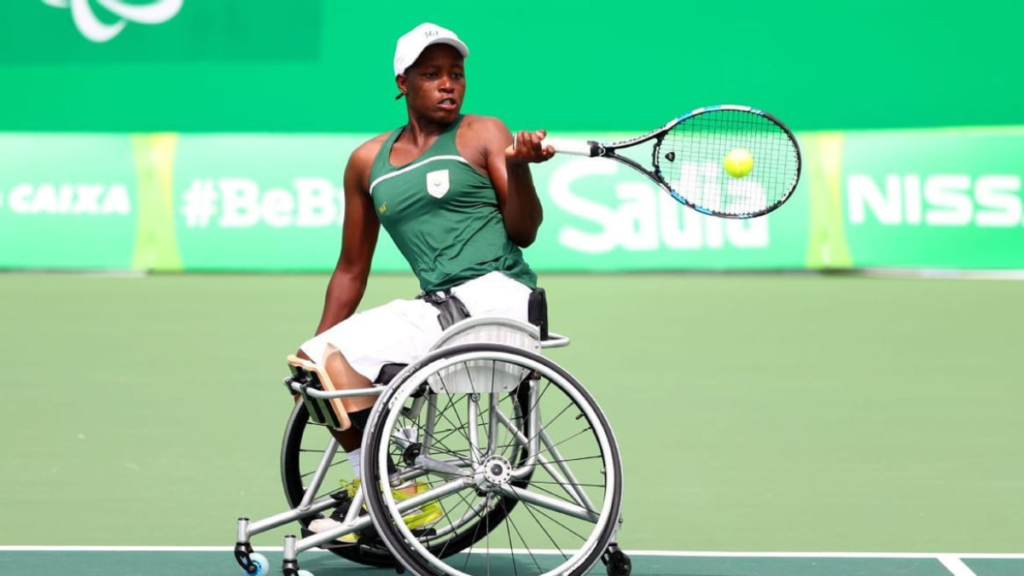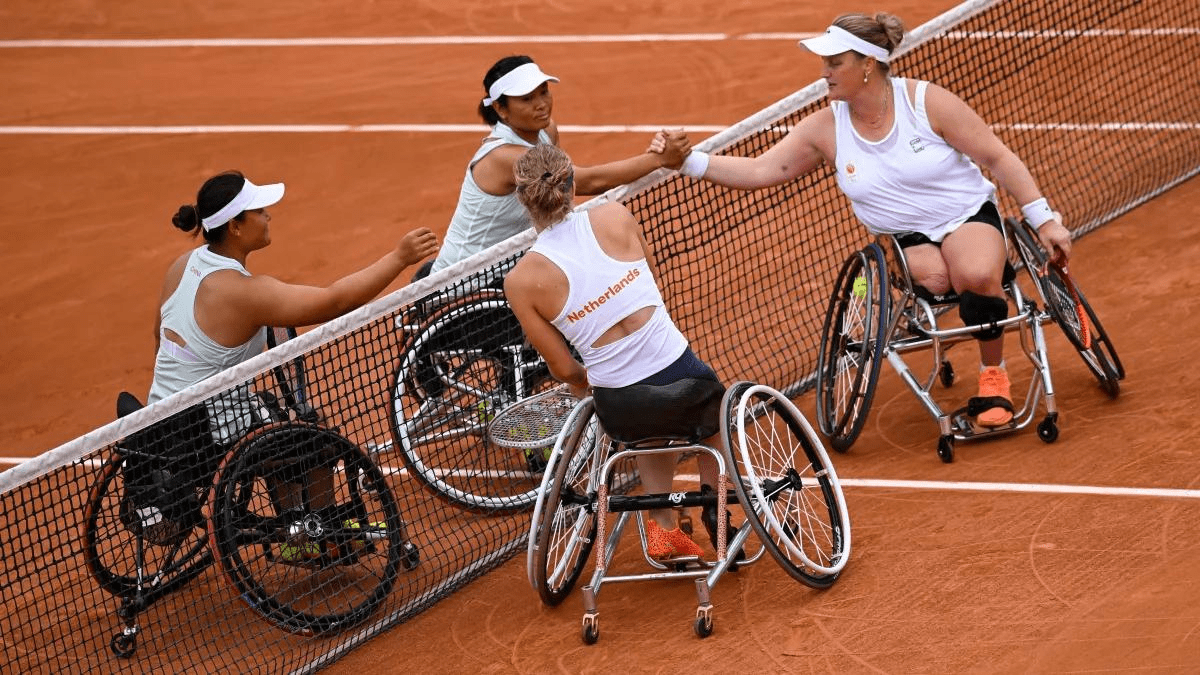wheelchair tennis paralympics 2024
“Spiders,” 100-meter sprints and basketball dunks: How wheelchair tennis players get faster on the court
Spider, butterfly, suicide… these are not the names of Marvel superheroes, but the names of power drills that wheelchair tennis players use to speed up the court.
And when it comes to playing on Roland Garros’ bouncy clay courts at the Paris 2024 Paralympic Games, speed is essential.
“I love it. The faster, the better for me,” Dutch quad player Niels Wink told Olympic.com about playing in the French tennis mecca. “My style of play is perfect for it, so I love clay.
Wink, a double medalist at Tokyo 2020, enjoyed intense play during his quarter-final win over Canada’s Robert Shaw on Monday (Sept 2), which he described as one of the “top five” matches of his career. Wink was also well prepared for the pace of this match.
The Dutch team, made up of Paralympic and Grand Slam champions including Wink, Dede de Groot, Anneke van Cott and Sam Schroeder, incorporates a variety of speed drills into their training to prepare for such fast games.
While the drills may be boring, they are anything but Dutch players who call them names like “spider” and “butterfly”. Other national delegations to Paris 2024 also inject fun into their wheelchair tennis training, learning to get faster by competing in friendly 100m sprints or wheelchair basketball games.
Read more about the creative ways wheelchair tennis players are gaining speed on the court, and why it’s important to their game.
More News: oasis ticketmaster reunion tickets set to go on sale
Wheelchair tennis drill names 101

Backhand, forehand, lob, slice, stroke – as a tennis player, you will have mastered all these movements. But can you hover like a butterfly or crawl like a spider?
In wheelchair tennis, these are the movements the players are working on as they fly backwards, forwards and sideways across the court.
“We have the ‘butterfly’, we have the ‘fan’ drill, we have the ‘dead bugs,’ which is a basic exercise. It’s lying on your back and doing your arms and legs at the same time. moving so you look like a dead bug on his back,” Britain’s Rio 2016 men’s singles champion Gordon Reid told Olympics.com.
“The ‘butterfly,’ it’s just a movement drill on the court. So he’s trying to mimic the movements of the forehand first and then the backhand because we move around the court in a figure-eight motion. This butterfly.” Like the shape that you’re going in.”
A “spider” is a drill where wheelchair tennis players make small figure eights around cones placed in the corners of the court. For the “Fan” drill, the athlete starts on the line in the middle of the court, moves to the right corner, back to the middle, then to the far left corner, and back to the middle.
There are also some exercises that pack a little more punch.
“You start on the doubles line, then you go to the singles line and to the middle line and back to the second singles line and back, and the doubles line and back,” Wink said. “And then you start over, and you do it twice. You have to make a big detour each time. We call it ‘suicide’.”
Whatever you call them, these are the exercises that Reed says are essential to staying on top in wheelchair tennis.
“On the movement side of things, for speed in the chair, we’re obviously doing a lot of strength work to get more powerful, but also agility and reaction, to try and stay fast. And to move well,” Reid said. “And then for the speed of the ball, from that point of view, it’s trying to be as free as possible in the shoulder and the rest. And obviously there’s a lot of stretching, physio and exercises involved.”
More News: American singer Fatman Scoop died during a live performance
From chasing tennis balls to 100m sprints

Although there are no wheelchair tennis exercises named after Cheetah or Gazelle, some of them are purely about speed. They are also the most entertaining.
British men’s athletes raced the 100m in the final week of their Paris 2024 training camp, and Reid was proud to announce the result.
“I won that one. I took the young guys out,” the four-time Paralympic medalist said with a smile. “I don’t think I’m breaking any records, but I’m happy to get the win.”
The Dutch team shortened their race to 20 meters and competed individually. However, like the Brits, they make sure to keep an eye on the results.
“We measure a lot, just to see if we’ve moved forward or backward,” de Groot told Olympics.com. “Maybe we’re steady, going at the same pace, but we also try to monitor it.”
For de Groot and his teammates, the focus is on explosive power. This is something that Argentina’s five-time Grand Slam winner Gustavo Fernandez also works on.
“We do explosive drills, trying to be quick to move around the court, especially in low moves because in tennis it’s very important to put yourself behind the ball and to do that, you have to be very strong. upper body,” explained Fernandez.
“We don’t do 100m. We do 10m, 5m, short distance movements and we try to manage that.”
Unfortunately for Fernandez, there are few wheelchair tennis players in Argentina competing in the 100m on the track. But should players from other countries choose to challenge him in this event, you can be sure he will be ready.
“In Argentina, normally, I don’t have many athletes to compete with, but I would like to compete in the 100 meters between all of us to see who wins,” Fernandez said, assessing his chances. Said before. “Gordon [Reid] is very fast. But I think I’ll be on top.”
More News: Oznur Cure Girdi crowns a dream performance with Paralympic gold
Turning training into a game

Diede de Groot has been involved in trying to improve his speed and agility on the court with recreational sports since he first started in the sport.
Growing up, she would challenge herself to pick up balls as fast as she could and play wheelchair tag with other kids to see how fast she could go.
“Playing tag, those were my favorite things. I probably wasn’t even tennis at seven, but pushing the chair and being fast and doing that with the other kids,” DeGroot said. “I think once you start enjoying it, it becomes fun and you want to do it.”
Making training fun is key for Turkey’s Ahmet Kaplan, whose wheelchair tennis sessions can easily turn into wheelchair basketball or American football games.
“We do some fun things with the team, with the coaches,” Kaplan said. “We do some exercises sometimes. We’re playing basketball on the tennis court or we’re throwing the ball at each other, playing American football.
“We’re just running like hell on the court. I feel like that’s also helping to stay active on the court, stay fast on the court.”
Besides being fun, the drills help the Turkish player stay alert while playing in wheelchair tennis matches, including a two-hour quarterfinal against Great Britain’s Andy Lapthorne on September 2.
“I’m on the court all the time,” Kaplan said. “If you stop in a wheelchair in tennis, you’re too late to hit the first push.” “You have to have your reflexes going all the time. It doesn’t matter what direction you’re moving, you can easily turn around. So I’m trying to move toward the court. Focus on.”
More News: What is open and closed on Labor Day 2024
Wheelchair tennis and the need for speed
While technique is critical to wheelchair tennis success, players also know that these skills cannot be executed well if they are not quick enough to reach the ball in time.
“Movement, that’s very important to us,” Wink said of the importance of speed and agility in his game. “For people with strength, you can go to one side, but we have to turn all the way, so the pushing technique has to be very good. And you always have to be very alert because when you have to turn to the other side It’s hard to get to the ball sometimes.”
His teammate De Groot doesn’t need to be reminded of the importance of moving quickly on the court. She has been practicing it since her early days in the game and speed is now one of her biggest weapons as a player.
“For the 10 years I’ve been a professional tennis player, I’ve always felt that pushing on the court is something that’s very important and maybe sometimes overlooked. So I’ve been that way from the beginning. I’m doing it,” he said. The Tokyo 2020 women’s singles champion, who is unbeaten in 145 matches until May 2024.
De Groot works out in the gym to improve her strength and thrusting power. On the court, training involves pushing around corners and going back and forth in a wheelchair, while in the gym the Dutch ace can work out on a bench or do push-ups to get stronger.
Colombia’s Angelica Bernal also puts in hours in the gym so she can get back on the field.
“We’re working really hard in the gym because you have to move the wheelchair and be fast and hit the balls hard, and you don’t know if you’re going to play for an hour or three hours, so it’s really hard work. There’s a gym,” Bernal told Olympics.com. “When I play wheelchair tennis, I feel like I fly on the court and can run and get every ball.”
Fly, yes, but can wheelchair tennis players be faster than that?
“Always, always,” Wink said. “If you don’t think you can get better or faster, you can stop.”
More News: Power cut off to 140 homes in Rancho Palos Verdes because of landslide danger


3 thoughts on “wheelchair tennis paralympics 2024”